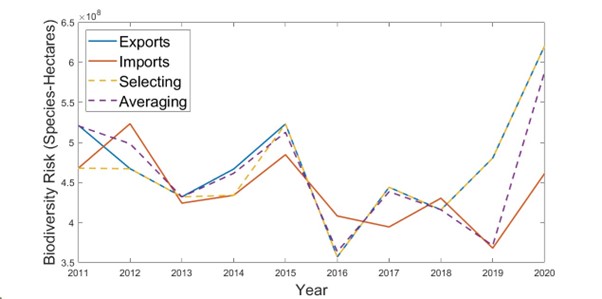Why effective trade data reconciliation can benefit biodiversity
PhD student Tyler Gaines discusses how countries, governments, and consumer groups are increasingly aware of the potential environmental consequences driven by their consumption behaviour.

One component of this issue is the consumption of traded commodities. Though consumption cannot be avoided, responsible decisions by economic actors can help to control some of the negative impacts.
I am interested in how trade decisions can influence consumption-driven biodiversity impacts. A country may have multiple sourcing options for a particular commodity, and they can use existing data to ascertain which option has the smallest biodiversity impact, and source accordingly. However, this approach is imperfect as, firstly, there are many metrics of biodiversity impact (Chaudhary and Kastner 2016), so a consumer’s perception of biodiversity impact is metric dependent. Secondly, the impact depends on production volume, which is influenced over time by a country’s sourcing decision (ie supply has to meet demand). Therefore, once a consumer has changed their source, the impact in the production regions will be different to the impact data initially used to inform their choice.
Practically speaking, these complications cannot be avoided completely, but it is possible to ensure that economic actors’ and policy makers’ decisions are better informed at the moment when the decisions are made. Consumption is linked to production by trade so, to robustly connect consumption to its impacts, accurate trade data are essential. Determining accurate trade data is a non-trivial problem because, for various reasons (Shaar 2019), import and export reports of trade interactions are often contradictory. Part of my research concerns trade data reconciliation, which is the process of comparing the importer- and exporter-reported trade records to algorithmically infer the ‘true’ trade data based on assessments of reporting quality. By reconciling trade data, we ensure that the data used to inform biodiversity impacts are as reliable as possible given the information available.
One aspect of my data reconciliation research is to evaluate the extent to which a choice of data reconciliation procedure can change estimations of associated biodiversity impact. I consider two reconciliation methods that are each chosen for their contrasting approaches. One is a ‘selecting’-based method (Shaar 2019), where the reconciled data are chosen, for each trade interaction, from whichever of the two reporters is most consistent with their partners; the other is an ‘averaging’-based method (Gaulier and Zignago 2010), where each reconciled trade flow is a weighted average between the two reports, with the weighting determined by assessments of reporter reliability. I use national-level trade data from FAOSTAT, and I use an existing metric (Croft et al. 2021) to estimate biodiversity risk in species-hectares.
Estimating biodiversity impacts from each of the reported and reconciled data sets, we can observe how estimated biodiversity impacts differ depending on the trade data. A particular example, illustrated in the figure below, shows the time series of estimated biodiversity risk in Brazil, specifically driven by imports of Brazil’s raw soybeans into Spain. Each line indicates the biodiversity risk as estimated using different trade data sets. There is one estimation for each of the reported and reconciled data sets, and we see that, in 2020, both reconciled trade data sets lead to an estimated biodiversity risk closer to the estimation based on the export report. Since the risk estimation based on the import report is far lower than the other estimations, it is likely that the import record may have been underreported that year, especially considering that the risk estimations are more consistent in earlier years.

Time series of estimated biodiversity risk in Brazil driven by imports of raw soybeans into Spain.
In general, trade data reconciliation provides additional insight when there are large discrepancies between the reported flows of a trade system. This insight has consequences for the estimated associations between consumption and biodiversity risk. Though it is an advantage to have these tools, it is still unclear what makes one reconciliation procedure superior to another. This is sometimes important, such as in 2019 on our plot where the reconciliation procedures reach opposite conclusions about which report is more reliable. In my research, I use synthetic data which are generated to incorporate discrepancies that arise from known causes. These data are used to evaluate the efficacy of reconciliation procedures in different plausible situations. Once there is a sufficiently comprehensive evaluation of method efficacy, we will be able to estimate trade-linked biodiversity risk more reliably and robustly. This research will facilitate better decision making as part of policy to reduce consumption-driven biodiversity impacts.
Related links
Find out more about Tyler Gaines' research.
Related links
Find out more about Tyler Gaines' research.